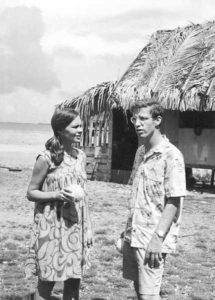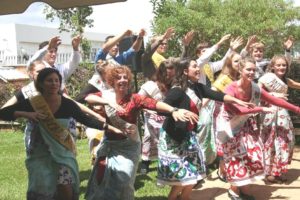On September 22, 1961, President John F. Kennedy signed the Peace Corps Act, securing the long-term continuation of an ideal inspired nearly a year before by candidate Kennedy. Since then, nearly a quarter of a million Americans have volunteered to serve the developing nations of the world in 141 countries.
The idea for the Peace Corps was just that—an idea—spoken by John Kennedy during a campaign visit to the University of Michigan on October 14, 1960. Kennedy had arrived late in Ann Arbor, but to not disappoint a crowd of 10,000 Michigan students waiting to hear him, he agreed to speak at 2 AM for a few minutes. During those remarks, he posed the idea of young Americans volunteering abroad:
“How many of you who are going to be doctors, are willing to spend your days in Ghana? Technicians or engineers, how many of you are willing to work in the Foreign Service and spend your lives traveling around the world? On your willingness to do that, not merely to serve one year or two years in the service, but on your willingness to contribute part of your life to this country, I think will depend the answer whether a free society can compete.”

Almost immediately, Michigan students and other began volunteering to do just what Kennedy had asked—even though no program existed. The idea was so popular, however, with polls showing 71% approval rate, that Kennedy began using it as a core part of his final drive to win the election.
And as soon as he was elected, he assigned R. Sargent Shriver to get the project started. With Shriver’s encouragement, President Kennedy signed an executive order on March 1, 1961, establishing a temporary Peace Corps (March 1 is often considered the birthday of the Peace Corps). Congress passed bills to establish it permanently, with its own appropriation, and President Kennedy signed the act into law on September 22, 1961. The simple two-page law established an idealistic purpose for the agency:
“…the purpose of this Act to promote world peace and friendship through a Peace Corps, which shall make available to interested countries and areas men and women of the United States qualified for service abroad and willing to serve, under conditions of hardship if necessary, to help people of such countries and areas in meeting their needs for trained manpower, and to help promote a better understanding of the American people on the part of the peoples served and a better understanding of other people on the part of the American people.”

Since then, the Peace Corps has remained a stalwart part of America’s international development aid and diplomacy. According to official Peace Corps statistics, as of September 30, 2016, more than 225,000 Americans have served in 141 countries. Today, about two-thirds are women; 30% are minorities. The average age of volunteers is currently 28, and 7% are older than 50. Nearly half (47%) of Peace Corps volunteers work in Africa, targeting the part of the world in most need of improved nutrition, health care and education. The second biggest target is Latin America, with 19% of all volunteers.
The Peace Corps program understands the essential connection between poverty, public health and the environment—the idea of sustainability as defined by Gro Harlem Brundtland and now used throughout the world. Consequently, 9% of Peace Corps volunteers work in environmental and conservation areas, including environmental education and awareness, protected area management and natural resource conservation. Another 7% work in agriculture.
References:
National Archives Catalog. Act of September 22, 1961 (Peace Corps Act), Public Law 87-293, 75 STAT 612, Which Established a Peace Corp to Help the People of Interested Countries and Areas in Meeting Their Needs for Skilled Manpower. Available at: https://catalog.archives.gov/id/299874. Accessed September 22, 2017.
Peace Corps. Environmental. Available at: http://files.peacecorps.gov/multimedia/pdf/learn/whatvol/onesheets/onesheets_environment.pdf. Accessed September 22, 2017.
Peace Corps. Fast facts. Available at: https://www.peacecorps.gov/news/fast-facts/. Accessed September 22, 2017.
Peace Corps. The Founding Moment. Available at: https://www.peacecorps.gov/about/history/founding-moment/. Accessed September 22, 2017.
Wofford, Harris. 2011. Big, Bold and Fast: A little Peace Corps history on its 50th Anniversary. Obama White House Archives. Available at: https://obamawhitehouse.archives.gov/blog/2011/03/01/big-bold-and-fast-little-peace-corps-history-its-50th-anniversary. Accessed September 22, 2017.
